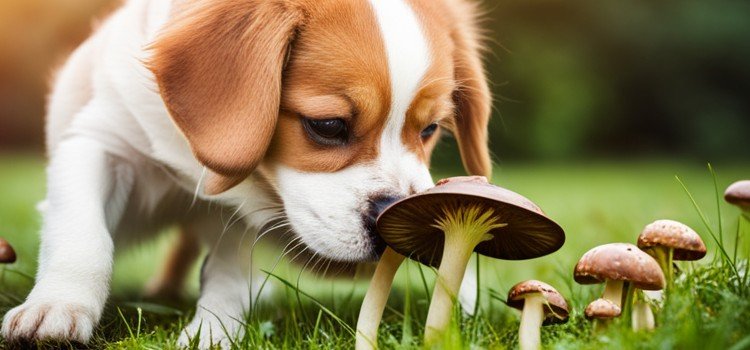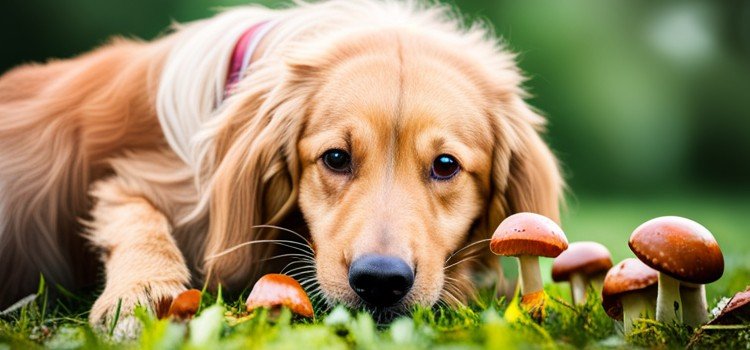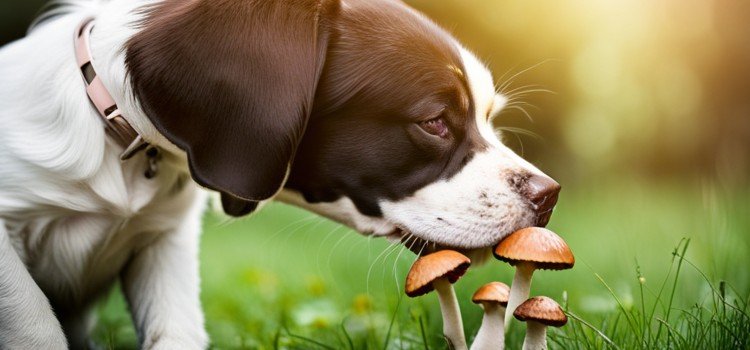As an Amazon Associate committed to the mission of improving the lives of our readers, Live-Clear.com receives a small commission from eligible purchases made through our affiliate links. This revenue enables us to keep producing insightful articles and other material.
Dogs are known for their extraordinary olfactory abilities. From finding lost items to detecting certain medical conditions, our furry companions have a nose for almost everything. One of the most intriguing questions is, “Can dogs smell mushrooms?” We are going to delve deep into the world of a dog’s sense of smell and investigate their capacity to detect mushrooms in this in-depth blog post that we have written. We’ll cover everything from the science behind their olfactory prowess to potential risks, and we’ll even answer some frequently asked questions along the way.

The Marvel of Canine Olfaction
The ability of dogs to detect odors is nothing short of remarkable. It’s estimated that they have between 300 million to 1 billion olfactory receptors in their noses, compared to a mere 5-6 million in humans. This immense olfactory capability allows dogs to perceive scents at concentrations nearly 100,000 times lower than humans.
Intriguingly, the part of a dog’s brain dedicated to processing smells is about 40 times larger than a human’s. This implies that a dog’s sense of smell is not only keen but also highly sophisticated.
This heightened sense of smell enables dogs to detect certain diseases and medical conditions in humans, such as cancer and diabetes, long before clinical diagnosis. Additionally, dogs are often trained to assist in search and rescue missions, where their exceptional olfactory abilities play a crucial role in locating missing individuals or detecting hidden substances.
The Mushroom Mystery
Why are dogs so interested in mushrooms? This question does not have a single response that can be considered final, although there are a few different answers that could be given to it:
- Aroma: Mushrooms have a strong and unique smell that is likely quite appealing to dogs. Their highly sensitive noses can pick up even the faintest whiffs of these earthy delicacies.
- Instinct: Dogs are natural foragers. Their ancestors, the wolves, were opportunistic scavengers, and this instinct to explore their environment and identify potential food sources has been retained in modern dogs.
- Variety: The world of mushrooms offers various species, each with its own scent. Dogs, being naturally curious, may be attracted to the diversity of mushroom scents.
Additionally, mushrooms contain compounds that mimic the pheromones of prey animals, which may further entice dogs to investigate and potentially consume them. However, dog owners need to be cautious as not all mushrooms are safe for dogs to eat, and some can be toxic or even deadly.
The Canine Mushroom Detector
Yes, dogs can indeed smell mushrooms. Their ability to detect mushrooms is a testament to their remarkable olfactory system. Dogs can differentiate the smell of mushrooms from other scents in their environment, even if they are hidden or buried underground.
One of the most astounding things about a dog’s sense of smell is their capacity to detect the presence of certain compounds, known as volatile organic compounds (VOCs), released by mushrooms. Different species of mushrooms emit unique combinations of VOCs, allowing dogs to distinguish between them.
Various professional fields, including agriculture and conservation, have harnessed this remarkable ability by using trained dogs to locate specific types of mushrooms. In particular, truffle-hunting dogs are famous for their ability to find expensive and elusive truffles in the wild.

Risks and Benefits
While a dog’s ability to smell mushrooms is fascinating, it raises concerns about potential risks and benefits.
Should You Be Concerned About Your Dog’s Mushroom-Sniffing Abilities?
There are certain aspects to consider when it comes to dogs and mushrooms:
1. Toxic Mushrooms: Some are highly toxic to humans and dogs. If your dog has a penchant for sniffing out mushrooms during walks, it’s crucial to be aware of the types of mushrooms that grow in your area. Toxic mushrooms like Amanita phalloides, also known as the Death Cap mushroom, can be lethal if ingested. It’s in everyone’s best interest if you can keep your dog from eating any wild mushrooms.
2. Accidental Ingestion: Dogs are known for their curious nature, and sometimes they may not just stop at sniffing. Inadvertently, they may consume mushrooms, leading to potential health risks. Symptoms of mushroom poisoning in dogs can range from gastrointestinal upset to organ failure, and they should be treated as a medical emergency.
3. Training and Supervision: Training your dog to avoid mushrooms during walks can be beneficial. Supervision is also crucial, especially if you live in an area where toxic mushrooms are prevalent. Keeping a watchful eye on your dog can help prevent any mushroom-related mishaps.
On the other hand, there can be some benefits to your dog’s fascination with mushrooms. Some non-toxic mushrooms, like the common white button mushroom, are safe for dogs to eat in small quantities and can provide nutritional benefits.
Are All Mushrooms the Same as Dogs?
While dogs can indeed smell mushrooms, they need to possess the knowledge to differentiate between edible and poisonous varieties. This is a crucial point of concern for dog owners. Dogs can’t recognize which mushrooms are safe to eat and which are toxic.
Many wild mushrooms are hazardous to both humans and dogs. Ingesting toxic mushrooms can lead to severe health issues, including gastrointestinal problems, organ damage, and, in some cases, even death. This is why it’s essential to keep a close eye on your dog when they show interest in mushrooms during your outdoor adventures.
The Safety Concerns
Now that we know dogs can smell mushrooms, it’s essential to address the safety concerns associated with this newfound ability.
- Ingestion of Toxic Mushrooms: Dogs are known to be curious creatures. If they stumble upon mushrooms in the wild, they might be tempted to investigate further, potentially leading to mushroom ingestion. It’s crucial to prevent your dog from eating wild mushrooms, as many can be toxic. If you suspect your dog has consumed a wild mushroom, seek immediate veterinary attention.
- Avoidance Training: If you live in an area where wild mushrooms are prevalent, it’s wise to invest time in training your dog to avoid them. This can help prevent unwanted encounters and keep your dog safe during walks.
- Mushroom Identification: If you’re an avid mushroom forager and your dog accompanies you on excursions, you must be extra vigilant. Ensure you can identify mushrooms confidently and keep your dog away from them. Many toxic mushrooms resemble edible ones, and the consequences of a mistake can be dire.
- Garden Mushrooms: Some homeowners cultivate edible mushrooms in their gardens. If you have mushroom patches at home, ensure your dog cannot access them. Even if they’re non-toxic, they may still upset your dog’s stomach.
- Stay Informed: Stay informed about the types of mushrooms that grow in your area, and be aware of their seasons. This knowledge will help you anticipate and manage the risks when walking your dog.
Additionally, it is essential to familiarize yourself with the appearance of toxic mushrooms to ensure you can quickly identify and remove them if they appear in your garden or on your walks. Educating yourself about the potential dangers can significantly reduce the risk of accidental ingestion by your dog. Remember, prevention is critical to keeping your furry friend safe from mushroom-related hazards.
Conclusion
In conclusion, dogs possess an incredible sense of smell that allows them to detect mushrooms and a wide range of other scents. While this ability is remarkable, it also comes with potential risks, particularly when it comes to toxic mushrooms. As responsible dog owners, it’s crucial to be aware of the types of mushrooms in your environment and take necessary precautions to keep your furry friend safe.
One necessary precaution is to always keep your dog on a leash during walks, especially in areas where mushrooms are known to grow. Additionally, it’s essential to educate yourself about the different types of toxic mushrooms that are common in your region so you can quickly identify and remove them from your yard or any other areas your dog may have access to.

FAQs
Not all dogs have the same level of olfactory ability, but most dogs have a keen sense of smell. Some breeds are known for their exceptional scent-detection skills, while others may need to be more proficient. However, any dog, regardless of breed, can be trained to detect specific scents, including mushrooms. Training your dog to see mushrooms can be a fun and rewarding activity that also helps keep them safe. It’s essential to consult with a professional trainer or behaviorist to ensure proper training techniques and safety precautions are followed.
If you suspect your dog has consumed a wild mushroom, contact your veterinarian immediately. It’s essential to get professional guidance as mushroom poisoning can be life-threatening. Symptoms of mushroom poisoning can vary depending on the type of mushroom ingested, so it’s crucial not to wait for symptoms to appear before seeking help. The veterinarian can provide the necessary treatment and advice to ensure your dog’s safety.
While some mushrooms from the grocery store are safe for dogs, it’s crucial to feed them in moderation and ensure they are thoroughly cooked. Mushrooms can be toxic in raw form, and some wild mushrooms may resemble safe ones. Therefore, it’s best to consult with a veterinarian before introducing any new type of mushroom into your dog’s diet. They can guide which varieties are safe and how to prepare them for your dog’s consumption properly.
Yes, some dog breeds are renowned for their superior olfactory senses. Species like the Bloodhound, Basset Hound, Beagle, and German Shepherd are often used in search and rescue missions, as well as in detecting various scents, including drugs and explosives. These breeds have a higher number of scent receptors in their noses, which allows them to see and track scents more effectively than other breeds. They can also improve their remarkable sense of smell by participating in targeted training programs.
Absolutely! Truffle-hunting dogs, for example, are trained to locate truffles, a type of valuable fungus that grows underground. Dogs can also be prepared for search and rescue operations, locating missing persons, or detecting specific diseases. These tasks require intensive training to teach dogs to recognize the particular scent they are searching for. Dogs have even been trained to detect cancer cells in people, displaying their remarkable smell talents.
Understanding your dog’s instincts and incredible olfactory capabilities can help you provide them with a safe and enriching environment. Whether your dog is simply curious about the scents of the natural world or you’re considering harnessing their abilities for practical purposes, their nose is truly a superpower worth exploring and respecting.
Amazon and the Amazon logo are trademarks of Amazon.com, Inc, or its affiliates.



